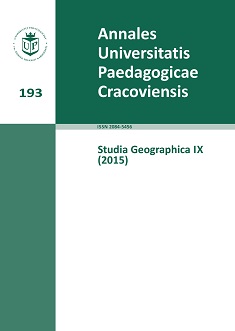Innovations in multicultural education as seen through the example of the Roma ethnic minority education in Poland
Keywords:
multicultural education, pedagogical innovations, Roma minority, social exclusionAbstract
Modern education, including geographic education, has to face new challenges. Unfortunately, in spite of the raising level of education, which has become common and natural, the processes of globalization and the higher standard of living, there still exist social groups that lag behind the majority in terms of socio-economic development. A particular example of such groups are ethnic and national minorities, for example the Roma ethnic minority in Poland. In spite of the fact that the Roma ethnic minority has been present in Poland for centuries, their actual education began 10 years ago, as the “Programme for the Roma community in Poland” took off. Before that, Roma children did not attend school at all, or ended education after a couple of years of primary school in “Roma classes”. The lack of education (often even illiteracy) and the negative stereotype of Roma in the Polish society caused the social exclusion of the Roma minority. In 2001, during the testing of the program in the Malopolska province, teachers faced a new challenge - multicultural teaching, difficult to implement in an ethnically homogeneous nation. In addition to language barriers, negative stereotype and reluctance of Romani parents to educate their children, the school staff also have to overcome cultural differences. However, in many schools education of Roma children is successful in integration classes, thanks to the efforts and preparation of supporting teachers and the new post of the Roma assistant. In the article, the authors focus on those innovative solutions in the field of development of the competence of educational staff, that enable the effective education of Roma children - the only way to fight with the social exclusion of the Roma minority.
References
Bartosz, A. (2004). Nie bój się Cygana. Na dara Romestar. Sejny: Fundacja Pogranicze.
Bitka, M., Janicki B. (2009). Historyczne komiksy edukacyjne dla Romów. W: B. Weigl (red.), Romowie 2009. Między wędrówką a edukacją. Warszawa: Wydawnictwo Szkoły Wyższej Psychologii Społecznej „Academica”, 129–131.
Dobrowolska, B. (2011). Sytuacja dziecka romskiego w szkole w latach 80. XX wieku i współcześnie. Toruń: Wydawnictwo Adam Marszałek.
Garczyńska, J., Gierała, Z. (2012). Rodzina Głowackich. Kwartalnik Romski, 5/2. Radom: Radomskie Stowarzyszenie Romów, 12–17.
Kwadrans, Ł. (2007). Charakterystyka sytuacji edukacyjnej Romów w Czechach, Polsce i Słowacji po 1989 roku. W: P. Borek (red.), Romowie w Polsce i Europie. Kraków: Wydawnictwo Naukowe Akademii Pedagogicznej, 233–248.
Milewski, J. (2004). Edukacja Romów w Polsce – wczoraj i dziś. W: J. Milewski (red.), Romowie, co każdy nauczyciel wiedzieć powinien. Suwałki: Wydawnictwo Stowarzyszenia „Integracja”.
Nowicka, E. (2007). Romowie i świat współczesny. W: P. Borek (red.), Romowie w Polsce i Europie. Kraków: Wydawnictwo Naukowe Akademii Pedagogicznej, 124–147.
Okoń, W. (1984). Słownik Pedagogiczny. Warszawa: PWN.
Oświata i wychowanie w roku szkolnym 2011/12, 2012, Warszawa: GUS, Departament Badań Społecznych.
Parfieniuk, I. (2001). Przygotowanie nauczyciela do pracy w środowisku zróżnicowanym etnicznie. W: Z. Jasiński, T. Lewowicki (red.), Oświata etniczna w Europie Środkowej. Opole: Wydawnictwo Uniwersytetu Opolskiego, 285–293.
Polska Akcja Humanitarna. Pozyskano z //www.pah.org.pl/nasze-dzialania/158/problem_dostepu_do_edukacji
Sprawozdanie z realizacji „Programu na rzecz społeczności romskiej w Polsce” w 2012 roku. Pozyskano z http://mniejszosci.narodowe.mac.gov.pl/mne/romowie/program-na-rzecz-spole/program-na-rzecz-spole/program-na-rzecz-spole–1/6978,Sprawozdania-z-realizacji-Programu-na-rzecz-spolecznosci-romskiej-w-Polsce-w–201.html
Ustawa z 6 stycznia 2005 roku o mniejszościach narodowych i etnicznych oraz o języku regionalnym, Dz.U. Nr 17, poz. 141.
Downloads
Published
Issue
Section
License
The submission of a paper to be published is synonymous with an agreement to transfer the copyright free of charge from the author to the publisher. The author also agrees to permit the publisher to publish the paper in printed form, open access online form, digital library form and other digital platforms with which the publisher has or will have a publishing agreement. Furthermore, the author agrees to not limit the number of copies that may be printed or issued by the publisher. In the case of co-authored papers, it is assumed that the corresponding author is authorized to represent the remaining co-authors in this respect. Authors are requested to sign a copyright declaration.

